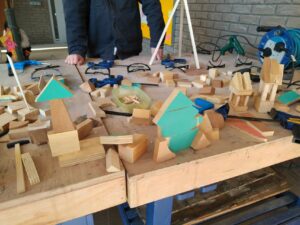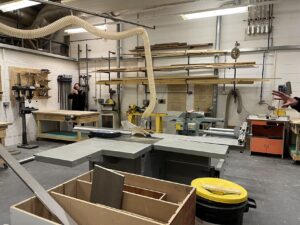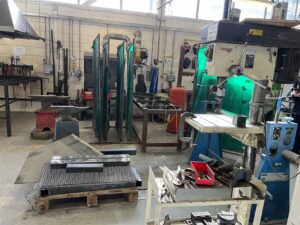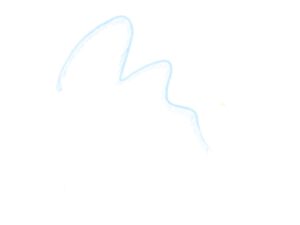Sprint 2 Open Art Toolkit reflective blog
Firstly, I would recommend defining the content of the art toolkit, its way of function, and the target audience (children, adults, art professionals, amateurs, etc.) as the focus of different projects may vary in terms of materials, quantity, and nature, and with limited funds available, it is best to specify the scope of the toolkit to avoid high building costs. This proposal was born after my visit to 21 Hawthornvale, Edinburgh Sculpture Workshop; this workshop runs two main programs, one for children, or families with children, and one for adults, mainly on an individual basis; while the first program offers kits of clay, wooden blocks or other plastic toys, and the activities can take place in an open and spacious outdoor area (Image 1), and the second program offers dedicated spaces for metal smelting, wood treatment, photography, and a single studio or materials room (Image 2). As can be seen, different project priorities may lead to very different preparation of the toolkit, so if it is not possible to support the development of a multi-line art toolkit for the time being, then try to concentrate on building a simpler toolkit first.



Image 1: toolkit for the first program


Image 2: toolkit for the second program
In addition, if you want to design the art toolkit as an open educational resource, there are three key points to note: the use of the web platform, the creation of a space for participants to interact with each other, and the need for the course content to be generalizable. I can use my Basho’s assignment from last week, ‘How to make the course ‘Drawn from the City’ more open’, as a case and then discuss it further concerning two learning theories. To make the course ‘Drawn from the City’ at the University of Edinburgh an open educational resource, our Basho made the following three suggestions:
- Construct an official learning website, (similar to the Myed learning, and may be called as Oured learning), provide the video recordings of the lecture, class or seminar online, and allow everyone to edit the reflective blogs or submit any assignment there
- Construct Bashos and find an online group discussion software, such as Miro or Teams, ensuring there could be an open place for everyone to share their ideas
- Adjust some course content. For example, do not limit the “city” in Edinburgh, but can use Edinburgh as a template and teach people the guideline that instructs how to explore the city as the artistic inspiration and allow everyone to observe and experience their own city and exchange their outcomes with each other in Basho
The first two suggestions can be understood in the context of Connectivism’s theory of learning. This theory states that “learning is a process of linking nodes and sources of information” and emphasizes the importance of linking and maintaining communication (Siemens, 2005). An open online platform and a space for learners to communicate is the foundation for ‘linking’, and creating links between all participants or nodes is bridging the gap for knowledge transfer. I further tested this theory and advice when completing the ‘self shape’ art assignment: the idea from the artist Tschabalala online trigger my reflection of my own body. When she talked about how she saw her body and created artistic symbols for her body, the nodes of her ideas form a strong link with my feelings. I was inspired by her and began to design my symbol.
The last recommendation regarding the generalizability of course content is grounded in the Constructivist perspective, a theory that insists that learning is personal and experiential and encourages learners to find their own unique path to individual expression (Helguera, 2012). The ‘openness’ of Open Educational Resources is therefore not only embodied in the physical and media accessibility of resources, but also the nature of the content. When discussing ‘Drawn from the City’, I think one of the major issues that prevented it from being an Open Educational Resource was that the content of the course may reject learners who had not been or could not be in Edinburgh, whereas the ‘self-shape’ art assignment was the opposite, in that it was inclusive of almost everyone because everyone could feel their own body and generate their ideas in their own interaction with it.
In ‘shape self’, I depicted myself as a light blue irregular curve (image 3), which comes from the fantasy and expectation of my body that I grew up with. This curve looks a little bit like a wing because I’ve always wanted my body to fly in the air; it can also be seen as a wave for I always desire to be able to move freely across the ocean. I made the curve blue as it is the color of the sky and the sea. This curve is irregular since I don’t want my body to be stylized in any way. It is clear that this art assignment has succeeded in translating my experience and expectations of my body into my artistic language and that the content of the course is easily replicable and can be followed by the public. Therefore, the art toolkit as Open Educational Resources needs to ensure that its lessons or assignments evoke as much of the individual and unique experience of each learner as possible.

Image 3: my body symbol
References
Helguera, P. (2012) Education for Socially Engaged Art. New York: Jorge Pinto Books
Siemens, G. (2005) Connectivism: A Learning Theory for the Digital Age, the International HETL Review, Special Issue. Available at:




This blog draws on the experience of the Edinburgh Sculpture Workshop, supported by an analysis of two learning theories, to illustrate your understanding of how to design an artist’s toolkit as an OER. I agree with your ideas: 1 course should be easily replicable; 2 assignments should evoke as much of each learner’s individual and unique experience as possible. I hope to see you reflect more deeply in your future studies!
The blogger’s suggestion of designing different art kits for target groups, for example, different kits for children and adults, gave me something new to think about. I started by thinking of only one type of group, which was still too narrow. Although open education platforms provide open and free access to resources, what can be done to improve the low utilization of resources and the low quality of learning? Artwork is a one-way output process, so how can we get feedback?
This reflection mentions the OER tool that one envisages, and I think the suggestion of changing cities is a good one to increase the range of knowledge. But does this change the original purpose of the course, and if the purpose of the course is just to learn about the city of Edinburgh is there a better way for people from other places to create with elements of Edinburgh?
In Yirong’s portfolio, I learned that for her, this artistic task successfully transformed her experience and expectation of her body into her own artistic language, and her core view is that the content of the course is easy to copy and the public can follow. Therefore, the art toolkit, as an open education resource, needs to ensure that its courses or assignments evoke as much as possible the individual and unique experiences of each learner. This also made me reflect critically. I think I have a deeper understanding of the significance of OER, not only for the dissemination of learning content and experience, but also to integrate the unique feelings of each individual.
very good! In this article, the author recorded a detailed learning process, and reading it also caused me to think. I agree with this point of view. That is, the art toolkit of open educational resources needs to ensure that its courses or assignments evoke each learning as much as possible. the personal and unique experience of the user.
The author put forward her own opinions on art toolkit and recorded the learning process and experience in the Edinburgh Sculpture Workshop in detail. In addition, she also put forward her own opinions on OER, and the introduction of connectionism impressed me deeply.
Yirong Fan, this was a great consolidation of your previous posts, and as your peers have highlighted, provides some interesting points of provocation to consider when moving into producing your own artist toolkit.
Understanding the audience of your toolkit and considering what kind of learning theories relate to them is a good way of trying to ensure that your toolkit is effective. Often, not doing this leads to an uncomfortable blending of applicability of a toolkit and limits the potential for it to be used beyond basic forms of learning.